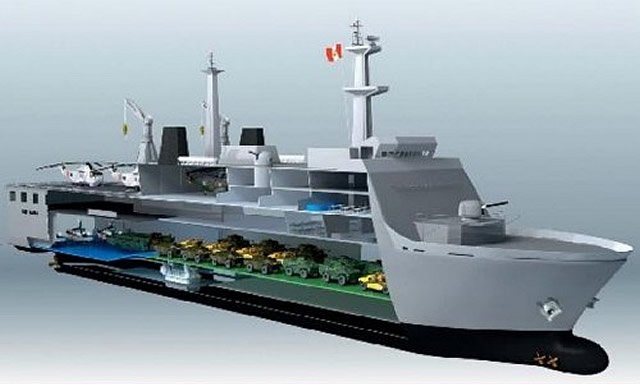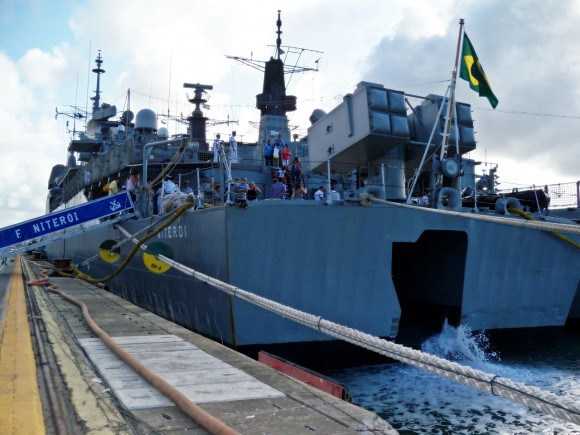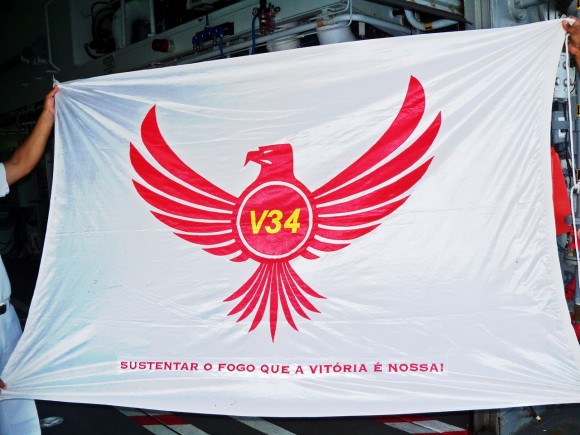Les grandes ambitions navales de la France au Brésil

Manoeuvres franco-brésiliennes avec le groupe Jeanne d'Arc en 2012 (© MN)
Un plan d’acquisition pouvant aller jusqu’à une trentaine de bâtiments
C’est dans cette perspective que le Brésil a lancé le PAEMB, un ambitieux programme de renouvellement de sa marine, afin d’assoir son statut de première puissance d’Amérique latine et protéger les importantes ressources de son espace maritime. A ce titre, la flotte de surface doit être renouvelée avec le programme PROSUPER, portant sur la construction de 5 frégates, 5 patrouilleurs hauturiers et un ravitailleur. Puis, dans le cadre du projet PRONAE, un nouveau porte-avions doit être réalisé afin de remplacer le vieux São Paulo (ex-Foch de la Marine nationale), qui date de 1963. Mais les ambitions navales brésiliennes vont au-delà, puisque la marine envisage en fait une trentaine de nouveaux bâtiments, qui pourraient être constitués d’un mixage de constructions neuves et de bâtiments d’occasion.
Concernant les nouveaux patrouilleurs, si les Britanniques ont emporté un beau succès dans ce domaine en vendant au Brésil l’an dernier les trois OPV (Offshore Patrol Vessels) réalisés initialement par BAE Systems pour Trinidad et Tobago (un contrat assorti d’un transfert de technologie pour la réalisation locale d’unités supplémentaires), l’industrie française est aussi présente dans ce domaine. Ainsi, une série de 12 patrouilleurs du type Vigilante 400 CL54, un design développé par les Constructions Mécaniques de Normandie (CMN), est en cours de réalisation au chantier INACE de Fortaleza, trois unités ayant été livrées depuis 2009.

La FREMM Aquitaine (© DCNS)
Frégates, ravitailleurs et porte-avions
DCNS, de son côté, propose au Brésil ses nouvelles frégates multi-missions (FREMM), dont l’Aquitaine est la tête de série. L’escale du bâtiment français à Rio est donc de première importance pour présenter aux autorités brésiliennes le dernier bijou technologique de l’industrie navale tricolore, ainsi que les différentes variantes et options proposées sur FREMM. Une plateforme flambante neuve qui n’est certes pas encore admise au service actif au sein de la Marine nationale (elle réalise actuellement son premier grand déploiement en vue d’une mise en service d’ici la fin de l’année), mais dont les essais et entrainements ont déjà démontré les importantes capacités, notamment en terme de lutte anti-sous-marine, grâce à son sonar remorqué de nouvelle génération (Captas 4 de Thales) et l’hélicoptère embarqué NH90, dont un exemplaire est actuellement à bord. Au-delà de la polyvalence et de la puissance de ses systèmes, DCNS mettra en avant la forte automatisation du bâtiment, qui lui permet de naviguer avec un équipage réduit de moitié par rapport aux frégates de la génération précédente. Mais aussi la maintenance réduite des FREMM, l’ensemble permettant de diminuer significativement les coûts d’exploitation.

FREMM, Brave et nouveau design de porte-avions (© DCNS)
En dehors des frégates, DCNS peut également proposer son nouveau concept de bâtiment logistique, le Brave, développé par les chantiers STX France de Saint-Nazaire. Les industriels tricolores sont aussi en mesure de se positionner, même s’il s’agit d’un projet plus lointain, sur une coopération avec le Brésil dans le cadre d’un nouveau porte-avions à brins d’arrêt et catapultes, une technologie que seuls les Français maîtrisent en dehors des Américains.
Certes, d’autres pays convoitent l’important plan de développement de la marine brésilienne : Britanniques, Italiens, Allemands, Espagnols ou même Coréens opposent une concurrence très vivent et espèrent bien, eux aussi, s’ouvrir de nouveaux débouchés. Mais DCNS a des atouts, non seulement la qualité de ses produits, mais aussi son implantation locale grâce à PROSUB, le colossal programme des nouveaux sous-marins brésiliens.

Vue du futur chantier naval à Sepetiba (© DCNS)
Une alliance franco-brésilienne née avec les sous-marins
Depuis 2009, DCNS forge, ainsi, un véritable partenariat stratégique avec la marine et l’industrie brésiliennes, afin que celles-ci puissent se doter des sous-marins les plus modernes. Au travers du programme PROSUB (Programma de Submarinos), le groupe apporte toute son expertise dans la conception et la réalisation de sous-marins. Il démontre sa capacité à assurer la maîtrise d’œuvre de projets complexes, initier des partenariats durables et mener à bien d’importants transferts de technologie.
En septembre 2009, DCNS a signé, avec PROSUB, le plus important contrat export de son histoire, soit 6.7 milliards d’euros engrangés avec son partenaire brésilien Odebrecht. Le programme porte sur la réalisation, en transfert de technologie, de quatre sous-marins conventionnels de type Scorpène (S-BR), l’assistance à la conception du premier sous-marin nucléaire d’attaque brésilien, ainsi que la livraison de torpilles lourdes F21. En outre, DCNS fournit une assistance à la maîtrise d’ouvrage d’un nouveau chantier et d’une nouvelle base navale situés à Itaguaí, dans la baie de Sepetiba, à l’ouest de Rio de Janeiro. Pour mener à bien cet ambitieux programme, DCNS s’est allié à Odebrecht pour créer Itaguaí Construções Navais (59% Odebrecht, 41% DCNS), société chargée d’assurer la réalisation des sous-marins. DCNS s’appuie ainsi sur un partenaire industriel puissant. Fondé en 1944, Odebrecht, acteur brésilien de premier plan (plus de 10 milliards d’euros de chiffre d’affaires, 90.000 salariés dont 34.000 au Brésil), est un groupe à rayonnement international spécialisé dans le génie civil, les travaux publics, l’industrie pétrochimique, l’offshore et les centrales nucléaires civiles. Des savoir-faire complémentaires à ceux de DCNS, qui permettront de mener à bien PROSUB.

Equipe brésilienne en formation à Cherbourg (© DCNS)
Transfert de technologie
Afin de porter ce programme, il a fallu mettre en place une organisation complète et coordonner un vaste montage industriel entre le Brésil et la France. Moins d’un an après la signature du contrat, la production du premier sous-marin a débuté le 27 mai 2010 au centre DCNS de Cherbourg. L’établissement français du groupe a réalisé la partie avant du S-BR 1, qui a servi de support pour permettre aux Brésiliens d’acquérir la technologie et les compétences nécessaires à la réalisation de sous-marins de nouvelle génération. La dernière jonction des tronçons de la section avant du S-BR 1 a été réalisée en décembre 2011 par une équipe franco-brésilienne de 12 soudeurs. En tout, plus de 150 techniciens, ingénieurs et marins brésiliens ont été accueillis à Cherbourg pour recevoir une formation de 3 mois leur permettant d'obtenir les qualifications requises. « Nous avons formé les Brésiliens à la construction de sous-marins en France, afin qu’ils puissent ensuite reproduire le savoir-faire acquis au Brésil », précise-t-on chez DCNS, qui a dispensé plus de 10.000 jours de formation entre 2010 et 2012. Désormais achevée, la partie avant du S-BR 1 quittera la pointe du Cotentin au printemps pour rejoindre Sepetiba, où elle sera aménagée puis assemblée à la partie arrière, réalisée localement, là aussi avec l’assistance technique française.

Partie avant d'un Scorpène, ici chilien (© DCNS)
Intégration au tissu industriel local
Au Brésil, la montée en puissance d’ICN se déroule conformément au calendrier prévu. Comme pour tous les groupes étrangers souhaitant développer des projets au Brésil, une installation dans le pays, une alliance avec des partenaires nationaux et une intégration au tissu économique local était indispensable. Dès 2008, le groupe naval français avait créé une tête de pont, DCNS Do Brasil, filiale chargée d’assurer sa représentation, développer son activité et gérer les relations institutionnelles avec les autorités politiques et militaires brésiliennes. Destinée à démontrer la volonté du groupe de s’insérer durablement dans le tissu industriel brésilien, assurer une présence de proximité et mieux connaître un pays qui évolue très rapidement, DCNS Do Brasil a pu, suite à la signature du contrat PROSUB, appuyer la création d’ICN, comme elle une société de droit brésilien. Chargée de porter industriellement PROSUB, Itaguaí Construções Navais, qui employait 80 personnes il y a un an, verra en 2013 ses effectifs atteindre un millier de collaborateurs, Brésiliens pour l’essentiel.

Formation à la soudure sur le site de Cherbourg (© DCNS)
Développer et maintenir des compétences
Afin de réaliser le programme, la filiale de DCNS et Odebrecht a entrepris de construire un réseau de fournisseurs locaux pour l’acquisition d’équipements destinés aux sous-marins, le but affiché du programme étant de démultiplier les retombées sur l’industrie brésilienne. Pour y parvenir, ICN s’est entourée de partenaires locaux chargés d’identifier les sous-traitants et de l’aider dans les domaines de la contractualisation et du suivi de mise en œuvre de contrats avec les fournisseurs. Dans le même temps, un important volet consacré à la formation est mis en œuvre par ICN, en collaboration avec l’organisme brésilien SENAI et le ministère français de l’Education nationale. L’objectif est de fortifier et développer l’industrie brésilienne en proposant aux futurs ingénieurs, techniciens et ouvriers brésiliens des formations donnant accès à des diplômes reconnus. L’un des grands enjeux d’ICN est, en effet, de développer et maintenir des savoir-faire, ainsi que des emplois dans le pays, pour permettre la construction, puis la maintenance de sous-marins. A ce titre, l’entreprise a non seulement mis en place des stages en France, mais a aussi développé des partenariats avec les grandes écoles techniques et les centres de formation au Brésil. Elle a, par ailleurs, ouvert une école de soudure, afin que les personnels puissent acquérir les compétences spécifique à la réalisation de sous-marins.

Vue du futur chantier et de la future base navale (© DCNS)
Un chantier colossal en baie Sepetiba
C’est sur cette base humaine et technique que repose PROSUB, un projet véritablement colossal par son ampleur. Au-delà des premiers travaux réalisés sur le S-BR 1, à Sepetiba, d’imposantes infrastructures sont sorties de terre : Une Unité de Fabrication de Structures Métalliques (UFEM), destinée à la réalisation de grandes sections pré-équipées de sous-marins, et un chantier naval doublé d’une base, où les sous-marins seront achevés puis entretenus. Les deux sites, séparés de 5 kilomètres, sont été reliés par une route et un tunnel, percé dans la colline. A l’instar de Laubeuf, à Cherbourg, le chantier attenant à la base sera doté d’une grande nef, où seront assemblées les sections réalisées par l’UFEM. Une fois assemblés, les bâtiments seront ensuite mis à l’eau au moyen d’un ascenseur.

Vue de l'UFEM (© DCNS)
Placés sous la responsabilité d’Odebrecht, les travaux, titanesques, dureront en tout 5 ans et représentent 9000 emplois directs et 27.000 emplois indirects. DCNS fournit, dans ce cadre, une assistance à la maîtrise d’ouvrage : « Nous apportons à nos partenaires brésiliens notre savoir-faire en termes d’infrastructures. Ainsi, nous travaillons sur les spécifications techniques des bâtiments, des installations et des équipements nécessaires à la réalisation, l’exploitation et la maintenance de sous-marins ».
L’UFEM va travailler avec la société brésilienne Nuclep, située à proximité. Chargée de réaliser les tronçons de la coque résistante, Nuclep a fabriqué en 2012 une section de qualification, passée au crible par les ingénieurs de DCNS afin d’être certifiée, avant de débuter la réalisation des anneaux destinés à la partie arrière du premier sous-marin, qui sera aménagée par l’UFEM. La nef de construction du chantier doit, quant à elle, être achevée début 2015, date à laquelle elle accueillera les sections avant et arrière pour les « jonctionner ». Le S-BR 1 doit réaliser ses essais en mer en 2016, sa livraison étant prévue mi-2017. Entièrement réalisés au Brésil, les trois sous-marins suivants seront livrés au rythme d’une unité tous les 18 mois, soit, normalement, début 2019, mi-2020 et début 2022.

Inauguration de l'école de conception, en 2010 (© DCNS)
Assistance pour la conception du premier SNA brésilien
En parallèle, DCNS assiste la marine brésilienne pour la conception de son premier sous-marin nucléaire d’attaque. Le groupe intervient sur les parties non nucléaires du SN-BR, le développement de la chaufferie étant de la responsabilité des Brésiliens. En septembre 2010, une école de conception de sous-marins a été inaugurée sur le site DCNS de Lorient. Architecture d’ensemble, architecture système, aménagement, spécifications et choix des équipements… Vingt-cinq ingénieurs de la marine brésilienne y ont été formés par leurs homologues français durant deux ans. Forts de cet apprentissage, ils sont repartis pour le Brésil afin de débuter la phase d’avant-projet du SN-BR. DCNS les assistera avec une équipe d’ingénierie qui mobilisera 25 personnes d’ici la fin 2013. Le futur SNA brésilien, réalisé dans le nouveau chantier d’Itaguaí, doit être livré en 2025. Grâce à l’accord conclu avec la France, le Brésil va donc maîtriser la conception et la réalisation de sous-marins parmi les plus évolués du monde, une capacité stratégique répondant aux ambitions du géant sud-américain sur la scène internationale.

Scorpène chilien (© DCNS)
Des opportunités sur l’ensemble du marché sud-américain
L’importance des enjeux maritimes, notamment la protection des zones économiques et des richesses qu’elles recèlent, poussent le Brésil mais aussi les différents pays d’Amérique latine à développer leurs moyens navals. Et l’industrie française y joue sa partie depuis plusieurs décennies pour permettre aux marines de moderniser leurs équipements. « L’Amérique latine constitue une grande zone d’opportunités. Le marché le plus important est celui des sous-marins, pratiquement toutes les marines disposant de bâtiments du Type 209 qu’elles souhaitent moderniser ou remplacer », note un responsable commercial. Ainsi, en 1997, le Chili a commandé les premiers sous-marins du type Scorpène, conçus et commercialisés à l’époque par DCNS et l’Espagnol Navantia, qui ont depuis « divorcé ». Coréalisés à Cherbourg et Carthagène, les O’Higgins et Carrera ont été livrés en 2005 et 2006. DCNS a, par ailleurs, participé à la remise à niveau des deux unités chiliennes du Type 209, se faisant d’ailleurs une spécialité dans la modernisation de ce type de bâtiment de conception allemande. Ainsi, le système de combat français SUBTICS a été retenu pour équiper ces sous-marins, tout comme leurs homologues des marines équatorienne et vénézuélienne. Fort de cette expérience, DCNS pourra proposer des solutions autour du Scorpène et de l’Andrasta (son petit sous-marin conçu pour les opérations littorales), quand il s’agira, dans les 15 prochaines années, de remplacer les unités du Type 209. Dans le domaine des bâtiments de surface, on notera que DCNS a également été retenu par la marine colombienne dans le cadre de la modernisation des quatre frégates de la classe Padia. Aux côtés du champion national du secteur, d’autres industriels français oeuvrent aussi en Amérique du Sud. CMN, on l’a vu, avec ses designs de patrouilleurs, mais aussi le chantier vendéen Ocea qui, avec sa discrétion et son efficacité habituelles, se positionne également.

Patrouilleur du type Vigilante (© CMN)


















